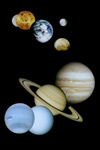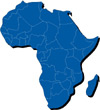4th-6th Grade
The Sky Tonight (Live)
The Sky Tonight is a full-length live tour of the night sky for the time of your visit. Students will learn the secrets to finding objects in the current sky, including the visible planets, constellations, some deep sky objects, and the Moon. We will also discuss some of the myths and legends associated with the celestial objects.
 Crashlanding Louie
(Taped)
Crashlanding Louie
(Taped)
Join the alien Louie on his journey through our solar system. His ship develops a problem and he must search our solar system for somewhere safe to land. He finds the Earth and, after some study, decides it’s his best bet. He crashes on Earth and while waiting for rescue he learns all about the Earth and everything he can see on it. He’ll need every piece of information about the Sun and Moon and how they move to guide his rescue party to him in safety. Will they make it? Visit the Ritter Planetarium to see Crashlanding Louie and find out.
Follow the Drinking Gourd (Taped)
Produced by the New Jersey State Planetarium, Follow the Drinking Gourd, a historical program, discusses how African-American slaves used the constellations, mainly the Big Dipper, to find their way north to freedom. Students will learn the song they memorized to assist them in their trip. They will also hear the tale of one African-American family and their successful journey north. This program also includes a live sky talk. Get program follow-up activities (pdf).
Bear Tales (& Other Grizzly Stories) (Taped)
Bear Tales, produced by Joe Hopkins Engineering Productions, takes us on a family camping trip out to the dark skies of the forest. Grandpa Ben tells tall tails about the night sky, including Greek and Egyptian mythologies. This program introduces the constellations of the spring sky. It also demonstrates the different views one gets with binoculars, telescopes, or just the human eyes. Bear Tales gets your students involved with generous doses of humor and a sing-a-long. Get program follow-up activities (pdf).
So, You Want to Be an Astronomer...? (Taped)
 So, You Want to
be an Astronomer...? is a Ritter Planetarium production that takes a look at backyard astronomy and examines
what astronomers do and how they
do it. It also looks at career options in astronomy. The program is the perfect introduction
to the night time sky, amateur astronomy, and the
life of astronomers for any student.
So, You Want to
be an Astronomer...? is a Ritter Planetarium production that takes a look at backyard astronomy and examines
what astronomers do and how they
do it. It also looks at career options in astronomy. The program is the perfect introduction
to the night time sky, amateur astronomy, and the
life of astronomers for any student.
Amazing Stargazing!! (Taped)
Produced by the Minneapolis Planetarium, Amazing Stargazing!! is a fun, fast-paced, and thrilling introduction to many aspects of the nighttime sky for all children. This radio-style program covers constellations, shooting stars, comets, and moons, among other things. If your group has never studied astronomy, this program is a marvelous way to introduce it. Get program follow-up activities (pdf).
Our Planet (Taped)
Wespend so much time exploring outer space here at the planetarium that it’s easy to forget we live on a planet in space, too. Our Planet takes a look at the Earth and how it interacts with Sun and Moon. Along the way, we discover why we have seasons, wind and rain, tides, and the Northern Lights.
Native American Skylore (Taped)
Native American Skylore is a look at the nighttime sky, the seasons, the phases of the Moon, and the motions of the planet Venus as seen through the eyes of Native Americans. Included are such topics as Serpent Mound, Native American myths and legends, and how ancient records are still useful to astronomers today.
Journey Through the Solar System (Live)
 Journey
Through the Solar System, (JTS), is an entirely new and updated version of our classic school program. It
begins with a live sky talk and
then moves on to an examination of the Sun and a tour of the nine planets and their
major satellites. Our current version of JTS includes some of
the most recent images available from the latest space expeditions. The program also
examines the minor members of our Solar System: comets,
asteroids, and meteors. Get program follow-up activities (pdf).
Journey
Through the Solar System, (JTS), is an entirely new and updated version of our classic school program. It
begins with a live sky talk and
then moves on to an examination of the Sun and a tour of the nine planets and their
major satellites. Our current version of JTS includes some of
the most recent images available from the latest space expeditions. The program also
examines the minor members of our Solar System: comets,
asteroids, and meteors. Get program follow-up activities (pdf).
Lifestyles of the Stars (Taped)
Lifestyles of the Stars is produced by Bowen Productions. In this program we join a tour group, climb aboard a celestial tour bus, and visit some of the biggest, brightest, and hottest stars in the universe. This fun, exciting, and educational program discusses how stars are born, live out their lives, and finally die. The program also includes a live sky talk.
Ancient Worlds (Live)
Ancient Worlds looks at the barren, rocky worlds of the Solar System: Mercury and our Moon. This program looks at the evolution of these worlds, and also at comets and meteors as clues to the early solar system. The program also discusses the birth of our star, the Sun. While Ancient Worlds can be customized to any age, it is strongly recommended that students be previously exposed to Journey Through the Solar System or its equivalent.
The Weather Out There (Taped)
Weall know how difficult the weather can be. But did you ever wonder what causes it? In this program, your group will learn why we have weather on the Earth and what the weather would be like if we lived on other planets. Bring your group to experience twisters here on the Earth, dust storms on Mars, and acid rain on Venus!
Skywatchers of Africa (Taped)
 Since the beginning of human
experience, the people of Africa have used their knowledge of the sky to meet their
physical needs for survival, and for navigation. They have
used the sky as a guide to build their societies, and for calendar making. The sky
also shapes their spiritual lives, playing an important role
in many ceremonies and providing clues to the deepest human questions. Skywatchers of Africa, produced by the Adler Planetarium,
examines several cultures, past and present, from across the African continent. It
shows how these examples are similar to the experience of
people all around the world.
Since the beginning of human
experience, the people of Africa have used their knowledge of the sky to meet their
physical needs for survival, and for navigation. They have
used the sky as a guide to build their societies, and for calendar making. The sky
also shapes their spiritual lives, playing an important role
in many ceremonies and providing clues to the deepest human questions. Skywatchers of Africa, produced by the Adler Planetarium,
examines several cultures, past and present, from across the African continent. It
shows how these examples are similar to the experience of
people all around the world.
Jovian Worlds (Live)
Jovian Worlds examines the four massive gaseous planets of our Solar System: Jupiter, Saturn, Uranus, and Neptune. This program discusses these worlds, their satellites, and their rings. It also contains the latest information on Pluto and the possibility of trans-Plutonian worlds. Once again, we strongly recommend that students be previously exposed to Journey Through the Solar System, or its equivalent, to gain the maximum potential benefit from this program.
Celestial Motions (Live)
Celestial Motions fully utilizes the capabilities of the central star projector. Your students will be introduced to the daily, annual, and precessional motions of the Earth; the reasons why we have seasons and eclipses; and why the Moon (and some of the planets!) go through phases. The unique environment of the planetarium is virtually essential in teaching these concepts. We strongly advise that all students be exposed to this program, or a similar one, at least twice during their academic careers. Get program follow-up activities (pdf).
See how these programs meet Science Education Standards.


